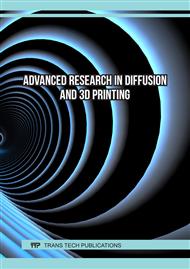[1]
R. Bird, W. Stewart, and E. Lightfoot. Transport phenomena. AIChE Journal, 7(2):5J-6J, 1961.
Google Scholar
[2]
G.I. Taylor. The dispersion of matter in turbulent flow through a pipe. Proceedings of the Royal Society of London. Series A. Mathematical and Physical Sciences, 223(1155):446-468, 1954.
DOI: 10.1098/rspa.1954.0130
Google Scholar
[3]
V.P. Shukla. Analytical solutions for unsteady transport dispersion of nonconservative pollutant with time-dependent periodic waste discharge concentration. Journal of Hydraulic Engineering, 128(9):866-869, 2002.
DOI: 10.1061/(asce)0733-9429(2002)128:9(866)
Google Scholar
[4]
C. Zheng and G.D. Bennett. Applied Contaminant Transport Modeling: Theory and Practice. Wiley, 1995.
Google Scholar
[5]
P. Dulal and S. Khan. A time dependent mathematical model for dispersion of air pollutants from point sources. International Journal of Environmental Studies, 35(3):197-208, 1990.
DOI: 10.1080/00207239008710565
Google Scholar
[6]
M. Sommerfeld and W. Krebs. Particle dispersion in a swirling confined jet flow. Particle & Particle Systems Characterization, 7(1-4):16-24, 1990.
DOI: 10.1002/ppsc.19900070104
Google Scholar
[7]
J.F. Sini, S. Anquetin, and P.G. Mestayer. Pollutant dispersion and thermal effects in urban street canyons. Atmospheric Environment, 30(15):2659-2677, 1996.
DOI: 10.1016/1352-2310(95)00321-5
Google Scholar
[8]
O.D. Makinde, R.J. Moitsheki, and B.A. Tau. Similarity reductions of equations for river pollution. Applied Mathematics and Computation, 188(2):1267-1273, 2007.
DOI: 10.1016/j.amc.2006.10.082
Google Scholar
[9]
R.J. Moitsheki and O.D. Makinde. Symmetry reductions and solutions for pollutant diffusion in a cylindrical system. Nonlinear Analysis: Real World Applications, 10(6):3420-3427, 2009.
DOI: 10.1016/j.nonrwa.2008.09.026
Google Scholar
[10]
T. Chinyoka. Analysis of nonlinear dispersion of a pollutant ejected by an external source into a channel flow. Mathematical Problems in Engineering, 2010:827363, 2010.
DOI: 10.1155/2010/827363
Google Scholar
[11]
T. Chinyoka and O.D. Makinde. Viscoelastic modeling of the diffusion of polymeric pollutants injected into a pipe flow. Acta Mechanica Sinica, 29:166-178, 2013.
DOI: 10.1007/s10409-013-0016-3
Google Scholar
[12]
T. Chinyoka, Y.Y. Renardy, M. Renardy, and D.B. Khismatullin. Two-dimensional study of drop deformation under simple shear for oldroyd-b liquids. Journal of Non-Newtonian Fluid Mechanics, 130(1):45-56, 2005.
DOI: 10.1016/j.jnnfm.2005.07.005
Google Scholar
[13]
M. Ma, J. Lu, and G. Tryggvason. Using statistical learning to close two-fluid multiphase flow equations for a simple bubbly system. Physics of Fluids, 27(9):092101, 2015.
DOI: 10.1063/1.4930004
Google Scholar
[14]
G. Tryggvason, M. Ma, and J. Lu. Dns-assisted modeling of bubbly flows in vertical channels. Nuclear Science and Engineering, 184(3):312-320, 2016.
DOI: 10.13182/nse16-10
Google Scholar
[15]
P. Li, C. Peng, P. Du, Y. Zhang, B. Dong, and M. Ma. The investigation of the viscous fingering phenomenon of immiscible fluids displacement by the lattice boltzmann method. Canadian Journal of Physics, 98(7):650-659, 2020.
DOI: 10.1139/cjp-2019-0120
Google Scholar
[16]
A.S. Warke, K. Ramesh, F. Mebarek-Oudina, and A. Abidi. Numerical investigation of the stagnation point flow of radiative magnetomicropolar liquid past a heated porous stretching sheet. Journal of Thermal Analysis and Calorimetry, 147(12):6901-6912, 2022.[17] C. Rajashekhar, F. Mebarek-Oudina, H. Vaidya, K.V. Prasad, G. Manjunatha, and H. Balachandra. Mass and heat transport impact on the peristaltic flow of a ree-eyring liquid through variable properties for hemodynamic flow. Heat Transfer, 50(5):5106-5122, 2021.
DOI: 10.1002/htj.22117
Google Scholar
[18]
S. Gourari, F. Mebarek-Oudina, O.D. Makinde, and M. Rabhi. Numerical investigation of gasliquid two-phase flows in a cylindrical channel. Defect and Diffusion Forum, 409:39-48, 2021.
DOI: 10.4028/www.scientific.net/ddf.409.39
Google Scholar
[19]
F. Mebarek-Oudina. Numerical modeling of the hydrodynamic stability in vertical annulus with heat source of different lengths. Engineering Science and Technology, an International Journal, 20(4):1324-1333, 2017.
DOI: 10.1016/j.jestch.2017.08.003
Google Scholar
[20]
T. Chinyoka. Computational Dynamics of a Thermally Decomposable Viscoelastic Lubricant Under Shear. Journal of Fluids Engineering, 130(12), 10 2008. 121201.
DOI: 10.1115/1.2978993
Google Scholar
[21]
T. Chinyoka. Poiseuille Flow of Reactive Phan-Thien-Tanner Liquids in 1D Channel Flow. Journal of Heat Transfer, 132(11):111701, 08 2010.
DOI: 10.1115/1.4002094
Google Scholar
[22]
T. Chinyoka. Buoyancy effects on unsteady mhd flow of a reactive third-grade fluid with asymmetric convective cooling. Journal of Applied Fluid Mechanics, 8:931-941, 2015.
DOI: 10.18869/acadpub.jafm.67.223.22865
Google Scholar
[23]
T. Chinyoka and O.D. Makinde. Numerical analysis of the transient and non-isothermal channel flow of a third-grade fluid with convective cooling. Engineering Transactions, 68(4):335-351, 2020.
Google Scholar
[24]
T. Chinyoka. Comparative response of newtonian and non-newtonian fluids subjected to exothermic reactions in shear flow. International Journal of Applied and Computational Mathematics, 7(3):1-19, 2021.
DOI: 10.1007/s40819-021-01023-4
Google Scholar


